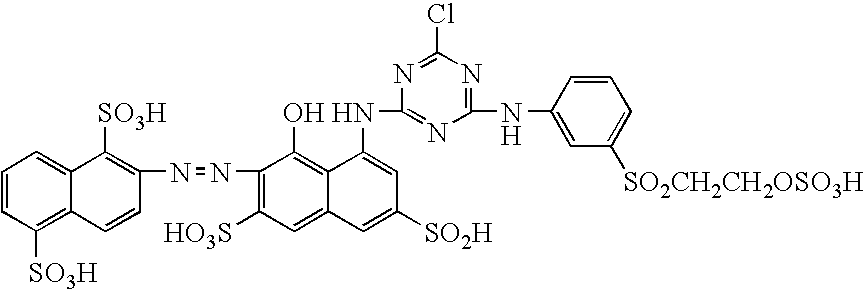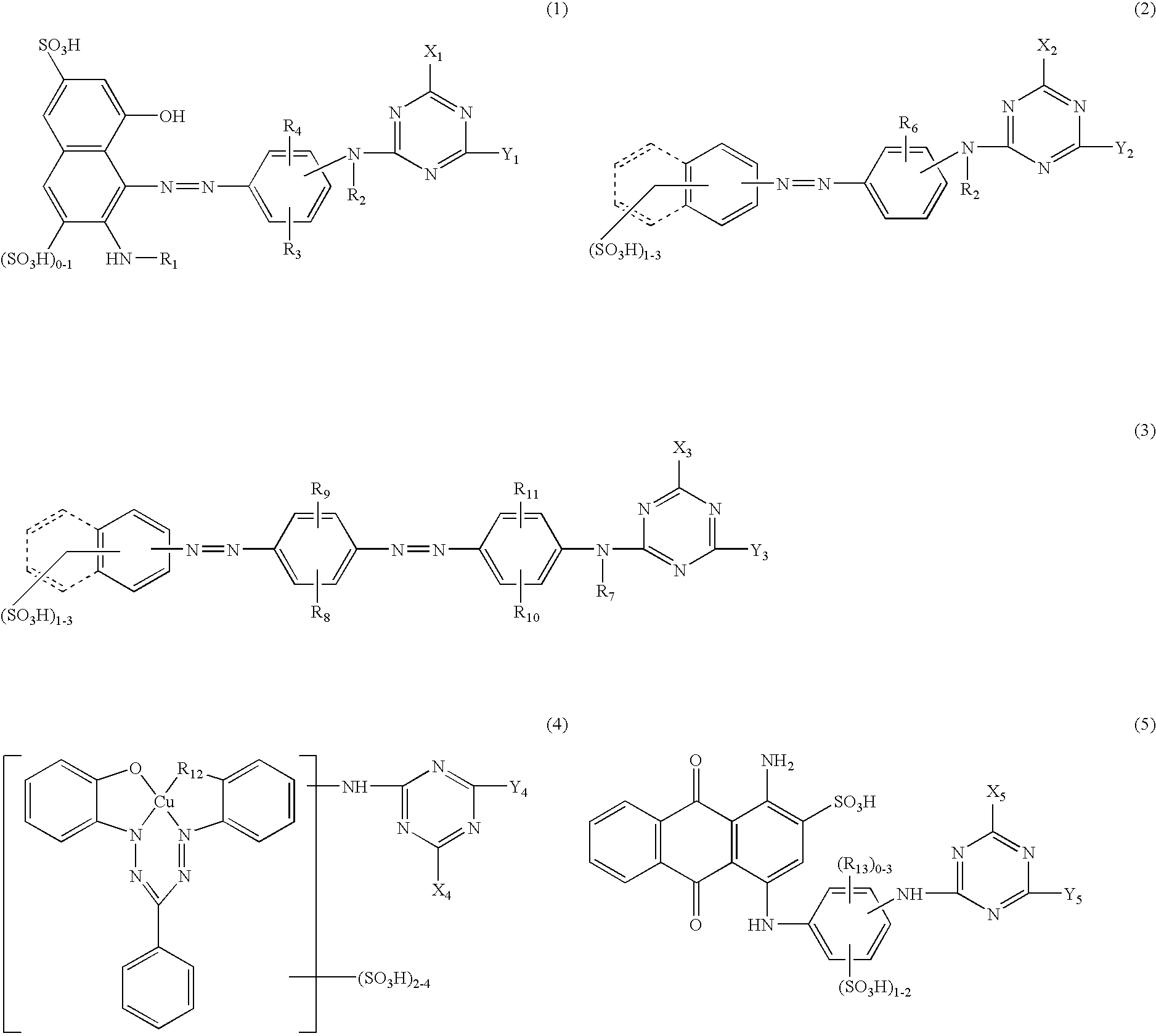Novel reactive dye composition with three-color combination
a reactive dye and composition technology, applied in the direction of organic dyes, textiles and papermaking, chemistry apparatus and processes, etc., can solve the problems that the use of conventional reactive red dyes cannot keep up with such requirements, red dyes have suffered from problems, etc., to achieve high light fastness, improve the adsorption and fixability, and improve the effect of color saturation
- Summary
- Abstract
- Description
- Claims
- Application Information
AI Technical Summary
Benefits of technology
Problems solved by technology
Method used
Image
Examples
example 1
[0048] 51.8 g of a compound of Formula 15 as shown below was dissolved in 500 g of water, and 100 g of ice was added to the resulting solution which was then cooled. 19.0 g of cyanuric chloride was added to the solution and the mixture was stirred and reacted at 5° C. and pH 5 for 2 hours. Thereafter, 22.5 g of 2-aminoethyl-2′-sulfatoethylsulfone was added and condensation was carried out at 30° C. and pH 7.5. 31.0 g of 3-sulfatoethylsulfone-1-aminobenzene was added to the resulting solution and the reaction was completed at 70° C. and pH 2.5. The reaction solution was filtered to remove insoluble materials, followed by salting out using 150 g of sodium chloride. The resulting crystals were dried to obtain 92.5 g of a compound of Formula 16 as shown below:
example 2
[0049] 51.8 g of the compound of Formula 15 was dissolved in 500 g of water, and 100 g of ice was added to the resulting solution which was then cooled. 19.0 g of cyanuric chloride was added to the solution and the mixture was stirred to complete the reaction at 5° C. and pH 5 for 2 hours. Thereafter, 22.5 g of 2-aminoethyl-2′-sulfatoethylsulfone was added, and condensation was carried out at 30° C. and pH 7.5. 9.0 g of morpholine was added to the resulting solution and the reaction was completed at 80° C. and pH 9. The reaction solution was filtered to remove insoluble materials, followed by salting out using 130 g of sodium chloride. The resulting crystals were dried to obtain 81.5 g of a compound of Formula 17 as shown below:
example 3
[0050] 43.8 g of a compound of Formula 18 as shown below was dissolved in 500 g of water, and 100 g of ice was added to the resulting solution which was then cooled. 19.0 g of cyanuric chloride was added to the solution and the mixture was stirred to complete the reaction at 5° C. and pH 5 for 2 hours. Thereafter, 31.3 g of 2-(N-ethylamino)ethyl-2′-sulfatoethylsulfone was added thereto, and condensation was carried out at 25° C. and pH 7.5, thereby completing the reaction. The reaction solution was filtered to remove insoluble materials, and subjected to salting out using 130 g of sodium chloride. The resulting crystals were dried to obtain 83.5 g of a compound of Formula 19 as shown below:
PUM
| Property | Measurement | Unit |
|---|---|---|
| pH | aaaaa | aaaaa |
| temperature | aaaaa | aaaaa |
| temperature | aaaaa | aaaaa |
Abstract
Description
Claims
Application Information
 Login to View More
Login to View More - R&D
- Intellectual Property
- Life Sciences
- Materials
- Tech Scout
- Unparalleled Data Quality
- Higher Quality Content
- 60% Fewer Hallucinations
Browse by: Latest US Patents, China's latest patents, Technical Efficacy Thesaurus, Application Domain, Technology Topic, Popular Technical Reports.
© 2025 PatSnap. All rights reserved.Legal|Privacy policy|Modern Slavery Act Transparency Statement|Sitemap|About US| Contact US: help@patsnap.com



